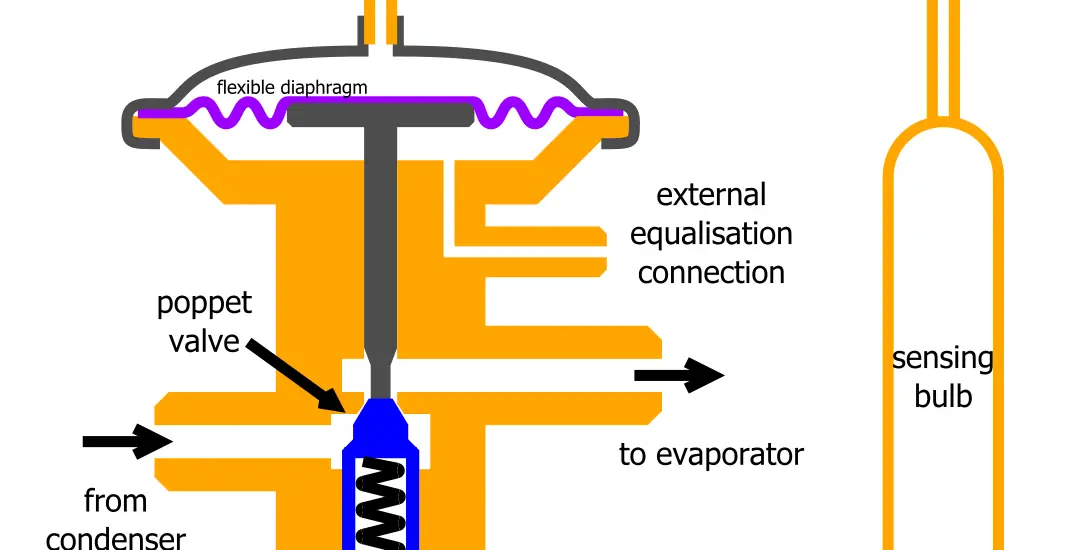Adjusting TXV for subcooling is an essential skill for maintaining an efficient HVAC system. In this comprehensive guide, you’ll find every detail you need, explained in straightforward terms, to make this task as smooth as possible.

Table of Contents
Safety Precautions
Before adjusting TXV for subcooling, taking safety precautions is absolutely essential. Here are the steps:
Disconnect Power: Turn off the HVAC system and unplug it from the electrical outlet to ensure there’s no electric current flowing through the system.
Safety Gear: Always wear protective gloves to protect your hands from sharp edges or hot surfaces. Safety goggles are recommended to protect your eyes from any unexpected splashes of refrigerant or debris.
Well-Ventilated Space: Ensure you’re working in a well-ventilated area. Refrigerants can be harmful if inhaled.
Tools You Will Need
Screwdriver: For opening panels and adjusting screws. (e.g. this Amazon-listed Amartisan 18-in-1 Multi-bit Screwdriver Set)
Wrench: For loosening and tightening nuts and bolts. (e.g. the Crescent 6″ Adjustable Black Oxide Wrench on Amazon)
Thermometer: To measure the refrigerant temperature.
Pressure Gauge: To measure the pressure of the refrigerant. (e.g. the Yellow Jacket 40345 Blue Single Test Pressure Gauge on Amazon)
Step-by-Step Guide to Adjusting TXV for Subcooling
This guide will offer you a sequential approach to adjusting TXV for subcooling. Follow each step meticulously:
Initial Assessment: Utilize a pressure gauge and a thermometer to record the existing subcooling levels. Attach the pressure gauge to the liquid line service valve and the thermometer to the liquid line. Do the calculations to know your current subcooling level.
Locate the TXV: It’s usually situated near the evaporator coil, often covered by a metal or plastic panel. Open this panel using a screwdriver.
Identify the Adjustment Screw: The adjustment screw is commonly located at the bottom or the side of the TXV. It’s essential to identify it correctly as this is what you’ll be manipulating.
Adjust to Increase Subcooling: If you wish to increase subcooling, turn the adjustment screw counterclockwise. Take note that significant changes should be done in small increments to avoid drastic system changes.
Adjust to Decrease Subcooling: Conversely, to decrease subcooling, turn the adjustment screw clockwise. As before, gradual adjustments are safer and more manageable.
Re-assessment: After making the changes, use your pressure gauge and thermometer to reassess the subcooling levels. This confirms if further adjustments are needed.
Verifying the Adjustment
After adjusting TXV for subcooling , it’s important to ensure they’ve been effective. Here’s how:
Let the System Stabilize: Switch on your HVAC system and let it run for at least 30 minutes. This ensures any changes you’ve made have been fully integrated into the system’s operation.
Re-measure: Use the same pressure gauge and thermometer to measure the new subcooling levels. If they align with your desired levels, the adjustment was successful. If not, you may need to repeat the adjustment process.
Performance Check: Finally, assess if the system’s cooling performance has improved. Feel the air coming out of the vents, listen for any unusual sounds, and look out for any oddities like ice forming on the coils.
Check out these other related articles…
Expansion Valve Equalizer Line: The Ultimate Guide
Expansion Valve Icing Up: Fixed in 5 Easy Steps
How to Adjust Expansion Valve in 6 Easy Steps
How to Adjust Car AC Expansion Valve in 8 Easy Steps
Adjusting TXV Superheat: 6 Easy Steps to Follow
Why Adjust TXV for Subcooling?
The task of adjusting TXV for subcooling serves multiple critical purposes in your HVAC system. Improper subcooling levels can drastically affect the performance and efficiency of your HVAC unit. For example:
Energy Efficiency: When the subcooling level is not optimized, your system can consume more electricity, leading to higher energy bills.
System Longevity: An inadequately adjusted TXV can lead to either too much or too little refrigerant entering the evaporator coil, causing undue stress on the system and potentially reducing its lifespan.
Performance: Achieving the right subcooling level ensures that the refrigerant is at its most efficient state when it circulates through the system, leading to optimal cooling performance.